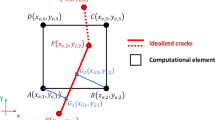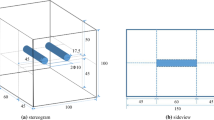Abstract
Corrosion-induced degradation at the steel–concrete interface (SCI) is spatially and temporally non-uniform in nature owing to the morphological changes it undergoes in a corroding environment. Several assumptions have been made in the literature to simplify numerical methods for simulating corrosion-induced damage. However, assumptions such as uniform mass loss, uniform thickness of the rust, and linear rate of corrosion, fail to capture the actual state of degradation at the SCI resulting in unrealistic simulations. While ultrasonic guided wave technique is widely used as a potential nondestructive tool for characterization of interfacial degradation, the impact of non-uniform degradation resulting from corrosion pits and rust formation on guided wave characteristics at the SCI has not been investigated. In the present work, the corroding SCI is modelled using a simulated point cloud which is generated from a multi-physics finite element (FE) model. Its impact on guided wave characteristics is investigated to establish realistic modelling practices at various phases of corrosion. It is found that the best modelling practice will be to model considering three different phases i.e. the first being ‘initiation phase’ as rust with three times the volume loss due to corrosion (RF3V), the second being ‘progression phase’ as a rust filled disjoint (RFD) followed by disjoint type (DT) and the third being ‘diameter reduction phase’ as disjoint type (DT). The energy envelops of guided wave signals for various phases of corrosion obtained from the proposed modelling sequence are compared with those obtained experimentally from an accelerated corrosion setup. The comparision shows good agreement between both the results. The guided wave characteristics are correlated with the maximum pit depth which forms the basis for nondestructive evaluation of the current state of corrosion induced strength degradation at SCI and it has valuable applications in the field of service life estimation of corroding reinforced concrete (RC).

















Similar content being viewed by others
Data Availability
The datasets generated during and/or analysed during the current study are available from the corresponding author on reasonable request.
References
Capital project and infrastructure spending Outlook to 2025, Research findings 2014 Research by Oxford Economics. www.pwc.com/cpi-outlook2025
Ma, Y., Xiang, Y., Wang, L., Zhang, J., Liu, Y.: Fatigue life prediction for aging RC beams considering corrosive environments. Eng. Struct. 79, 211–221 (2014). https://doi.org/10.1016/J.ENGSTRUCT.2014.07.039
Dang, V.H., François, R.: Prediction of ductility factor of corroded reinforced concrete beams exposed to long term aging in chloride environment. Cement Concr. Compos. 53, 136–147 (2014). https://doi.org/10.1016/J.CEMCONCOMP.2014.06.002
Ahmad, S.: Reinforcement corrosion in concrete structures, its monitoring and service life prediction––a review. Cement Concr. Compos. 25, 459–471 (2003). https://doi.org/10.1016/S0958-9465(02)00086-0
Chauhan, A., Sharma, U.K.: Effect of real climate on non-uniform corrosion in reinforced concrete. ACI Mater. J. 116, 77–89 (2019)
Chauhan, A., Sharma, U.K.: Influence of temperature and relative humidity variations on non-uniform corrosion of reinforced concrete. Structures. 19, 296–308 (2019). https://doi.org/10.1016/J.ISTRUC.2019.01.016
Muehlenkamp, E.B., Koretsky, M.D., Westall, J.C.: Effect of moisture on the spatial uniformity of cathodic protection of steel in reinforced concrete. Corrosion 61, 519–533 (2005). https://doi.org/10.5006/1.3278188
Koretsky, M.D., Abooameri, F., Westall, J.C.: Evaluation of the performance of reference electrodes embedded in reinforcing concrete, Oregon department of transportation final report FHWA OR-RD-95-008, (1994). http://www.oregon.gov/ODOT/Programs/ResearchDocuments/EvalOfThePerformance.pdf
Koretsky, M.D., Abooameri, F., Westall, J.C.: Effect of concrete pore saturation on cathodic protection of steel-reinforced concrete bridges. Corrosion 55, 52–64 (1999). https://doi.org/10.5006/1.3283966
Gjorv, T.E., Vennesland, O.: Evaluation and control of steel corrosion in offshore concrete structures. Spec. Publ. 100, 1575–1602 (1987)
Kranc, S.C., Sagüés, A.A.: Computation of corrosion distribution of reinforcing steel in cracked concrete. Corros. Sci. 50, 1–12 (1994)
Geiker, M.R., Michel, A., Lepech, M.D., Wu, J., Stang, H.: Multi-scale and multi-physics deterioration modelling for design and assessment of reinforced concrete structures. RILEM Tech. Lett. 2, 119–128 (2017)
Sriramadasu, R.C., Lu, Y., Banerjee, S.: Identification of incipient pitting corrosion in reinforced concrete structures using guided waves and piezoelectric wafer transducers. Struct. Health Monit. 18, 164–171 (2019). https://doi.org/10.1177/1475921718809151
Sriramadasu, R.C., Banerjee, S., Lu, Y.: Sensitivity of longitudinal guided wave modes to pitting corrosion of rebars embedded in reinforced concrete. Constr. Build. Mater. (2020). https://doi.org/10.1016/J.CONBUILDMAT.2019.117855
Almusallam, A.A., Al-Gahtani, A.S., Aziz, A.R.: Rasheeduzzafar: Effect of reinforcement corrosion on bond strength. Constr. Build. Mater. 10, 123–129 (1996). https://doi.org/10.1016/0950-0618(95)00077-1
Coccia, S., Imperatore, S., Rinaldi, Z.: Influence of corrosion on the bond strength of steel rebars in concrete. Mater. Struct. 49, 537–551 (2016). https://doi.org/10.1617/S11527-014-0518-X
Raghavan, A., Cesnik, C.E.S.: Review of guided-wave structural health monitoring. Shock Vib. Digest. 39, 91–114 (2007). https://doi.org/10.1177/0583102406075428
Li, J., Lu, Y., Guan, R., Qu, W.: Guided waves for debonding identification in CFRP-reinforced concrete beams. Constr. Build. Mater. 131, 388–399 (2017). https://doi.org/10.1016/J.CONBUILDMAT.2016.11.058
Miller, T.H., Kundu, T., Huang, J., Grill, J.Y.: A new guided wave-based technique for corrosion monitoring in reinforced concrete. Struct. Health Monit. 12, 35–47 (2013). https://doi.org/10.1177/1475921712462938
Sharma, S., Mukherjee, A.: Nondestructive evaluation of corrosion in varying environments using guided waves. Res. Nondestr. Eval. 24, 63–88 (2013). https://doi.org/10.1080/09349847.2012.699609
Beniwal, S., Ganguli, A.: Defect detection around rebars in concrete using focused ultrasound and reverse time migration. Ultrasonics 62, 112–125 (2015). https://doi.org/10.1016/j.ultras.2015.05.008
Na, W.-B., Kundu, T., Ehsani, M.R.: Ultrasonic guided waves for steel bar concrete interface testing Acoustic Holography in Anisotropic Media View project InfinitPipe® for the Pipeline Infrastructure Construction and Repair Industry View project. https://www.researchgate.net/publication/285631801
Amjad, U., Yadav, S.K., Kundu, T.: Detection and quantification of diameter reduction due to corrosion in reinforcing steel bars. Struct. Health Monit. 14, 532–543 (2015). https://doi.org/10.1177/1475921715578315
Sun, H., Zhu, J.: Nondestructive evaluation of steel-concrete composite structure using high-frequency ultrasonic guided wave. Ultrasonics (2020). https://doi.org/10.1016/j.ultras.2020.106096
Ervin, B.L., Bernhard, J.T., Kuchma, D.A., Reis, H.: Estimation of general corrosion damage to steel reinforced mortar using frequency sweeps of guided mechanical waves. Insight 48, 682–692 (2006)
Rajeshwara, C.S., Banerjee, S., Lu, Y.: Identification of zero effect state in corroded RCC structures using guided waves and embedded piezoelectric wafer transducers (PWT). Procedia Eng 188, 209–216 (2017). https://doi.org/10.1016/J.PROENG.2017.04.476
Sriramadasu, R.C., Lu, Y., Banerjee, S.: Identification of pitting corrosion in steel bars and rebars embedded in concrete using ultrasonic guided waves. In: Proceedings of the 9th International Conference on Advances in Steel Structures, ICASS 2018. (2020). https://doi.org/10.18057/ICASS2018.P.163
Goudar, S.K., Das, B.B., Arya, S.B., Shivaprasad, K.N.: Influence of sample preparation techniques on microstructure and nano-mechanical properties of steel-concrete interface. Constr. Build. Mater. 256, 1–16 (2020). https://doi.org/10.1016/j.conbuildmat.2020.119242
Shetty, S., Banerjee, S., Tallur, S., Desai, Y.M.: Effectiveness of multiphysics modelling in simulating accelerated corrosion. arXiv:2112.11683 [physics.app-ph] (2021). https://doi.org/10.48550/arXiv.2112.11683
Fernandez, I., Berrocal, C.G.: Mechanical properties of 30 year-old naturally corroded steel reinforcing bars. Int. J. Concr. Struct. Mater. 13, 1–19 (2019). https://doi.org/10.1186/S40069-018-0308-X/FIGURES/18
Soodmand, E., Kluess, D., Varady, P.A., Cichon, R., Schwarze, M., Gehweiler, D., Niemeyer, F., Pahr, D., Woiczinski, M.: Interlaboratory comparison of femur surface reconstruction from CT data compared to reference optical 3D scan. Biomed. Eng. Online 17, 1–10 (2018). https://doi.org/10.1186/S12938-018-0461-0/FIGURES/5
Chen, X., He, K., Chen, Z., Wang, L.: A parametric approach to construct femur models and their fixation plates. Biotechnol. Biotechnol. Equip. 30, 529–537 (2016). https://doi.org/10.1080/13102818.2016.1145555
Yang, B.X., Duan, M.D., Zhang, Z.Y., Liu, J.B.: Three-dimensional solid reconstruction of femoral CT images based on reverse engineering. J. Phys. 1345, 032078 (2019). https://doi.org/10.1088/1742-6596/1345/3/032078
Andrade, C., Alonso, C., Gonzalez, J.A.: Remaining service life of corroding structures. In: Proceedings IABSE Symposium on Durability, Lisbon, pp. 359–363 (1989). https://doi.org/10.5169/seals-44238
Andrade, C.: Propagation of reinforcement corrosion: principles, testing and modelling. Mater. Struct. (2019). https://doi.org/10.1617/s11527-018-1301-1
Lundgren, K.: Modelling the effect of corrosion on bond in reinforced concrete. Mag. Concr. Res. 54, 165–173 (2002)
Sikdar, S., Banerjee, S., Ashish, G.: Ultrasonic guided wave propagation and disbond identification in a honeycomb composite sandwich structure using bonded piezoelectric wafer transducers. J. Intell. Mater. Syst. Struct. 27, 1767–1779 (2016). https://doi.org/10.1177/1045389X15610906
Azoor, R.M., Deo, R.N., Birbilis, N., Kodikara, J.K.: Coupled electro-chemical-soil model to evaluate the influence of soil aeration on underground metal pipe corrosion. Corrosion 74, 1177–1191 (2018). https://doi.org/10.5006/2860
Mir, Z.M., Höche, D., Gomes, C., Sampaio, R., Bastos, A.C., Maincon, P., Ferreira, M.G.S., Zheludkevich, M.L.: Enhanced predictive modelling of steel corrosion in concrete in submerged zone based on a dynamic activation approach. Int. J. Concr. Struct. Mater (2019). https://doi.org/10.1186/S40069-018-0321-0
Gutierrez-Miravete, E., Turner, M.: Modeling galvanic corrosion. (2013)
Grzeschik, L.: Modeling Crevice Corrosion of Nickel Alloy 625 in Seawater. Williams Honors College, Honors Research Projects. (2018) https://ideaexchange.uakron.edu/honors_research_projects/629
Deconinck, J.: Mathematical modelling of electrode growth. J. Appl. Electrochem. 24, 212–218 (1994). https://doi.org/10.1007/BF00242886
Corrosion Module User’s Guide (1998). www.comsol.com/blogs
Walsh, F.C.: Overall rates of electrode reactions. Faraday’s laws of electrolysis. Trans. Inst. Metal Finish 69, 155–157 (1991)
Deshpande, K.B.: Validated numerical modelling of galvanic corrosion for couples: magnesium alloy (AE44)-mild steel and AE44-aluminium alloy (AA6063) in brine solution. Corros. Sci. 52, 3514–3522 (2010). https://doi.org/10.1016/J.CORSCI.2010.06.031
Suda, K., Misra, S., Motohashi, K.: Corrosion products of reinforcing bars embedded in concrete. Corros. Sci. 35, 1543–1549 (1993). https://doi.org/10.1016/0010-938X(93)90382-Q
Sharma, S., Mukherjee, A.: Longitudinal guided waves for monitoring chloride corrosion in reinforcing bars in concrete. Struct. Health Monit. 9, 555–567 (2010). https://doi.org/10.1177/1475921710365415
Na, W.B., Kundu, T., Ehsani, M.R.: Lamb waves for detecting delamination between steel bars and concrete. Comput. Aided Civil Infrastruct. Eng. 18, 58–63 (2003). https://doi.org/10.1111/1467-8667.T01-1-00299
Knopoff, L.: A matrix method for elastic wave problems. Bull. Seismol. Soc. Am. 54, 431–438 (1964). https://doi.org/10.1785/BSSA0540010431
Rose, J.L.: Ultrasonic Guided Waves in Solid Media. Cambridge University Press, Cambridge (2014). https://doi.org/10.1017/CBO9781107273610
Mlrsky, I.: Wave propagation in transversely isotropic circular cylinders part I: theory. J. Acoust. Soc. Am. 37, 1016–1021 (1965). https://doi.org/10.1121/1.1909508
Mlrsky, I.: Wave propagation in transversely isotropic circular cylinders part II: numerical results. J. Acoust. Soc. Am. 37, 1022–1026 (1965). https://doi.org/10.1121/1.1909510
Sun, Z., Zhang, L., Rose, J.L.: Flexural torsional guided wave mechanics and focusing in pipe. J. Pressure Vessel Technol. Trans. ASME 127, 471–478 (2005). https://doi.org/10.1115/1.2065587
Seco, F., Jiménez, A.R.: Modelling the generation and propagation of ultrasonic signals in cylindrical waveguides. Ultrason. Waves (2012). https://doi.org/10.5772/29804
Courant, R., Friedrichs, K., Lewy, H.: On the partial difference equations of mathematical physics. IBM J. Res. Dev. 11, 215–234 (2010). https://doi.org/10.1147/RD.112.0215
el Maaddawy, T.A., Soudki, K.A.: Effectiveness of impressed current technique to simulate corrosion of steel reinforcement in concrete. J. Mater. Civ. Eng. 15, 41–47 (2003). https://doi.org/10.1061/(ASCE)0899-1561(2003)15:1(41)
Kashani, M.M., Crewe, A.J., Alexander, N.A.: Nonlinear stress-strain behaviour of corrosion-damaged reinforcing bars including inelastic buckling. Eng. Struct. 48, 417–429 (2013). https://doi.org/10.1016/J.ENGSTRUCT.2012.09.034
Andrade, C.: Reliability analysis of corrosion onset: initiation limit state. J. Struct. Integr. Maint. 2, 200–208 (2017). https://doi.org/10.1080/24705314.2017.1388693
Acknowledgements
Authors acknowledge the computational facility provided by CCES, IIT Bombay. The authors acknowledge the support from NMAM Institute of technology, Nitte during the course of this research work. Authors would like to thank Prof. R K Singh and Dr. Rajeshwara Chary Sriramadasu at IIT Bombay for their suggestions during the course of this research work.
Funding
The authors acknowledge the support of IMPRINT-2A by Science and Engineering Research Board, Department of Science & Technology, Government of India [Grant IMP/2018/001442] for the development of experimental facilities.
Author information
Authors and Affiliations
Contributions
SS: conceptualization, data curation, formal analysis, investigation, methodology, software, validation, visualization, writing—original draft. SB: conceptualization, methodology, investigation, resources, funding acquisition, supervision, writing—original draft, writing—review and editing. ST: conceptualization, methodology, investigation, resources, funding acquisition, supervision, writing—original draft, writing—review and editing. YMD: conceptualization, methodology, investigation, resources, supervision, writing—original draft, writing—review and editing.
Corresponding author
Ethics declarations
Conflict of interest
The authors declare that they have no known competing financial interests or personal relationships that could have appeared to influence the work reported in this paper.
Ethical Approval
Not applicable.
Consent to Participate
Not applicable.
Consent for Publication
Not applicable.
Additional information
Publisher's Note
Springer Nature remains neutral with regard to jurisdictional claims in published maps and institutional affiliations.
Rights and permissions
Springer Nature or its licensor holds exclusive rights to this article under a publishing agreement with the author(s) or other rightsholder(s); author self-archiving of the accepted manuscript version of this article is solely governed by the terms of such publishing agreement and applicable law.
About this article
Cite this article
Shetty, S., Banerjee, S., Tallur, S. et al. Point Cloud-Based Finite Element Model for Interaction of Ultrasonic Guided Waves with Non-uniform Corrosion in Reinforced Concrete. J Nondestruct Eval 41, 67 (2022). https://doi.org/10.1007/s10921-022-00897-8
Received:
Accepted:
Published:
DOI: https://doi.org/10.1007/s10921-022-00897-8




